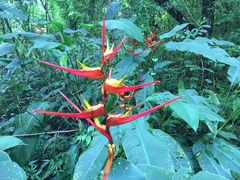
Neotropical Flora
|
Family: Heliconiaceae
|
Platanillo, Guacamaya Caulescent, rhizomatous herb, 1.5-3 m tall; stem flattened, 4-5 cm wide by 2-2.5 cm thick. Petioles often somewhat pruinose, 30-40 cm long; blades broadly oblong, rounded and cuspidate at apex, rounded to truncate at base, 50-100 cm long, 15-30 cm wide; veins 4-10 cm apart, branching from midrib at ca 90° angle. Inflorescence glabrous, erect; peduncle 15-30 cm long; rachis strongly flexuous, usually greenish; bracts broad at base, long-acuminate, spirally arranged, the lower 1-3 bearing leaves (occasionally with blades to 1 m long), the leafless ones 4-25 cm long, 2-3.5 cm high at base, red or orange except the lower proximal margin yellowish-green; flowers 4-5 cm long, orange to yellow with green margins, lying +/- flat in bract and mostly concealed by it. Fruits purple at maturity, broadly oblong, weakly trigonous, 8-10 mm long, emerging from bracts, the pedicels remaining concealed; seeds 3, ca 7 mm long. Croat 6368. Very common in the Lighthouse and Laboratory Clearings and occasional on the shore; a ubiquitous species along roadsides and the railroad right-of-way in the Canal Zone. Flowers throughout the rainy season, rarely during the dry season. Stiles (1975) reported that the species flowers mostly from May to August in Costa Rica. The fruits develop within about 1 month and are abundant on some plants during the middle to late rainy season. Recognized by its erect, glabrous inflorescence with much-spiraled, broad, red bracts often leafy at the base. Mexico to Colombia, Venezuela, and Ecuador; possibly elsewhere in South America. In Panama, known from tropical moist forest on both slopes in the Canal Zone and in probably all provinces. |
|
|
|
Powered by Symbiota.


























































































